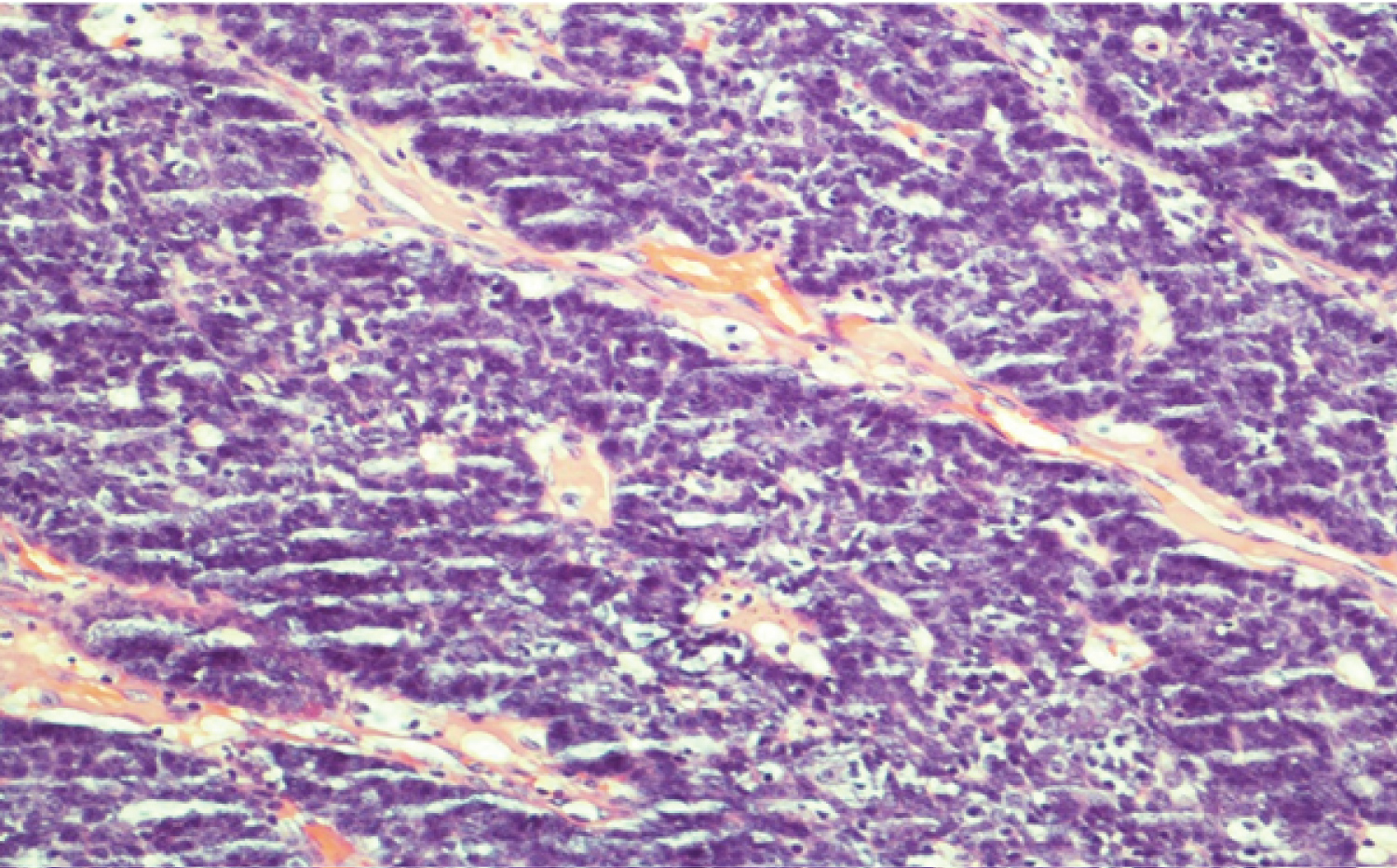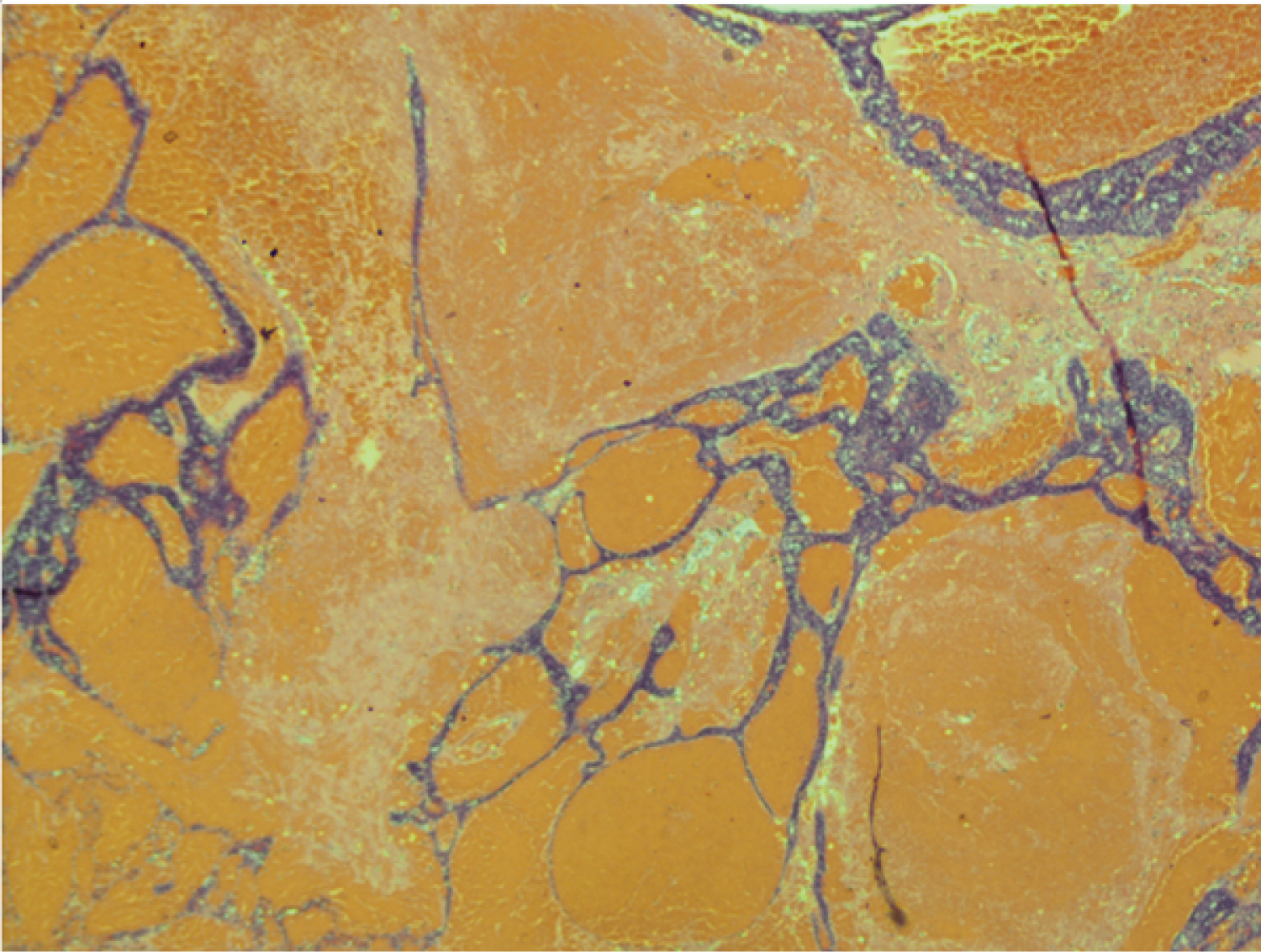Introduction: Eccrine Spiradenoma is a rare connective tissue tumor arising from the dermis of well differentiated eccrine sweat gland. It is considered benign nature, nonetheless, reported malignant cases are extremely rare. The most common presentation symptom is localized intradermal swelling and complete surgical excision is the gold standard in managing these cases.
Aim: This case report is undertaken to document a rare case of adnexal tumor of head and neck as well as sharing our experience to peer medical practitioners.
Case study: We present a case of a 68-year-old lady, presented to a tertiary medical centre with a localized nodular right posterior neck swelling for the past 10 years, which underwent complete excision.
Results and discussion: Following complete surgical excision and thorough surveillance, there is no evidence of recurrence and malignant transformation.
Conclusions: Eccrine Spiradenoma is an extremly rare adnexal tumor that could involve head and neck, with reported cases of recurrence and malignant transformation that need to be closely observed and intervened should it present.
Eccrine spiradenoma, Benign adnexal tumor, Recurrence, Malignant transformation
The occurrence of Eccrine Spiradenoma is considered as of extreme rarity. There are only 50 reported cases which were being mentioned in the literature till date [1-3]. Out of those, 18 cases (36%) were from head and region, and only 1 case (2%) associated with head and neck malignancy [3,4]. Eccrine Spiradenoma can arise from any region of the body, though it is most commonly seen from head and neck as well as anterior aspect of the trunk [1-4]. Patient commonly presents with localized, painful intradermal swelling in a form of nodule [1-4]. A complete surgical excision is the treatment of choice as this tumor has been reported to recur as well as risk for malignant transformation, though it is extremely rare [1-4].
A 68-years-old lady with no known medical illness, presented to the Sarawak General Hospital ENT clinic with right posterior neck nodular-cutaneous swelling for 10 years, which increased in size and painful for the past 1 month. She had no other ENT symptoms and denied any Tuberculosis symptoms such as night sweats, loss of weight or appetite. Family history and past medical history were insignificant. On examination, there was a tender, fixed intradermal lump located at the right level V of the neck, measuring approximately 2 × 2 cm, with distinct margin clinically. There was no punctum, skin ulceration nor satellite nodules seen and the underlying skin was normal there was no other lesion noted elsewhere. Endoscopic ENT and systemic examinations were unremarkable.
An excision biopsy was done under local anesthesia to remove the lump was performed. Intraoperatively, the lump was measured 1.5 × 1 cm, cystic in consistency, with smooth surface with clear plane and was completely separated from other structures. With no difficulties encountered, it was removed en-bloc and sent for histopathological examination (Figure 1, Figure 2 and Figure 3). She was discharged home well.
 Figure 1: This picture shows a well circumscribed and lobular nodule composed of cellular tumor arranged in organoid pattern (under 10X magnification).
View Figure 1
Figure 1: This picture shows a well circumscribed and lobular nodule composed of cellular tumor arranged in organoid pattern (under 10X magnification).
View Figure 1
 Figure 2: The tumor cells are round to oval with inconspicuous nucleoli and scanty cytoplasm. They are separated by dense fibro collagenous stroma (under 40X magnification). View Figure 2
Figure 2: The tumor cells are round to oval with inconspicuous nucleoli and scanty cytoplasm. They are separated by dense fibro collagenous stroma (under 40X magnification). View Figure 2
 Figure 3: Tumor with extensive areas of haemorrhage (under 10X magnification). View Figure 3
Figure 3: Tumor with extensive areas of haemorrhage (under 10X magnification). View Figure 3
On her subsequent clinic visit, her histopathological report confirmed the diagnosis of Eccrine Spiradenoma. Clinically, there was no evidence of residual and the wound healed. She was seen 2 months post excision and was well, subsequently being scheduled for series of long term follow ups, amid making sure that she remained asymptomatic prior discharging her for good.
Eccrine spiradenoma was first described by Kersting and Helwig back in 1956 [1,2]. The incidence is extremely rare with total of 50 reported cases till date in literature and only 8 cases are associated with malignant transformation [1-4]. There is no sex predilection and mostly seen in patient in between 15-35 years of age, nonetheless it could possibly appear at any age group [2,3].
There are various causes of head and neck swellings that can be listed down, which can be narrowed down fundamentally into two groups, which are infection and neoplasm. Differentials such as cervical lymphadenopathy, nasopharyngeal cancer, and tuberculosis could be higher up on the list considering that these diseases are endemic here in Sarawak. Eccrine Spiradenoma falls into the latter category and being considered as benign neoplasm. How many of us, as clinician, had encountered such case in our practice? Upon reviewing the histopathological report, the author himself needs to do some research to further understand this disease.
As being mentioned earlier, this disease is considered as one of the rare cases reported cases in literature [1,2]. Among those mentioned, only 8 of them were documented involving from the head and neck region [3]. Malignant transformation, on the other hand was seen in 8 cases throughout the entire body but only one case was reported to be from the neck [3,4]. In that case, the patient was reported to be an elderly 60 years of age male, presented with sudden increase in size of a cutaneous nodule after many years of dormant [3]. The nodule was successfully excised and the patient was being followed upto 10 years with no evidence of metastases or recurrence noted [3].
The patient that we described presented with classical presentation of Eccrine Spiradenoma. Her symptoms were relatively similar to those documented in literature. She was kept for series follow up visits, bearing in mind that though the disease is benign, the incidence of recurrence as well as malignant transformation do exist in such case [1,4]. Sudden increase in size after many years of dormant, skin ulcerations, satellite lesions even distant metastases were reported as features of malignancy [3,4]. In such cases, patient should be staged, and loco-regional issues such as lymph nodes, if present, should be addressed as well [4]. Most of the tumour were successfully excised, and in few cases, the regional lymph nodes were resected as well as part of the primary therapy [3,4]. Options of chemotherapy or radiotherapy were however not mentioned in the literatures so far. Amid risk of recurrence and malignancy, patients with this disease should be kept for long term surveillance.
The author has considered this case to be the 51st case of Eccrine Spiradenoma that has existed and reported, and the 9th case arising from head and neck region which remained benign until now. In view of the rarity of this case, it should be honored, worth written-up as well as sharing this valuable experience to fellow peer medical colleague. Learning from this experience, we suggest mirroring the practice done as shared in literature, whereby patient with Eccrine Spiradenoma should be followed upto 10 years long!
None.
None.
To the management of Sarawak General Hospital, Ministry of Health Malaysia for allowing us to use the facilities and full support to the production of this article.